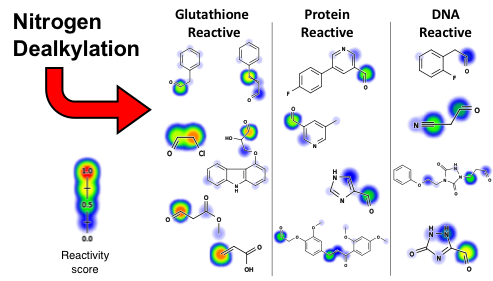https://pubs.acs.org/doi/pdf/10.1021/acs.chemrestox.7b00191
Na Le Dang, Tyler B. Hughes, Grover P. Miller, and S. Joshua Swamidass

Abstract: Cytochromes P450 (CYPs) oxidize alkylated amines commonly found in drugs and other biologically active molecules, cleaving them into an amine and an aldehyde. Metabolic studies usually neglect to report or investigate aldehydes, even though they can be toxic. It is assumed that they are efficiently detoxified into carboxylic acids and alcohols. Nevertheless, some aldehydes are reactive and escape detoxification pathways to cause adverse events by forming DNA and protein adducts. Herein, we modeled N- dealkylations that produce both amine and aldehyde metabolites and then predicted the reactivity of the aldehyde. This model used a deep learning approach previously developed by our group to predict other types of drug metabolism. In this study, we trained the model to predict N-dealkylation by human liver microsomes (HLM), finding that including isozyme-specific metabolism data alongside HLM data significantly im- proved results. The final HLM model accurately predicted the site of N-dealkylation within metabolized substrates (97% top-two and 94% area under the ROC curve). Next, we combined the metabolism, metabolite structure prediction, and previously published reactivity models into a bioactivation model. This combined model pre- dicted the structure of the most likely reactive metabolite of a small validation set of drug-like molecules known to be bioactivated by N-dealkylation. Applying this model to approved and withdrawn medicines, we found that aldehyde metabolites pro- duced from N-dealkylation may explain the hepatotoxicity of several drugs: indinavir, piperacillin, verapamil, and ziprasidone.
Our results suggest that N-dealkylation may be an under-appreciated bioactivation pathway, especially in clinical contexts where aldehyde detoxification pathways are inhibited. Moreover, this is the first report of a bioactivation model constructed by combining a metabolism and reactivity model. These results raise hope that more comprehensive models of bioactivation are possible. The model developed in this study is available at https://swami.wustl.edu/xenosite/.

You must log in to post a comment.